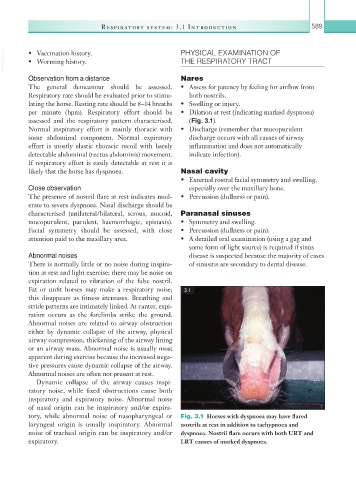Page 614 - Equine Clinical Medicine, Surgery and Reproduction, 2nd Edition
P. 614
Respir atory system: 3.1 Introduction 589
VetBooks.ir • Vaccination history. PHYSICAL EXAMINATION OF
THE RESPIRATORY TRACT
• Worming history.
Observation from a distance Nares
The general demeanour should be assessed. • Assess for patency by feeling for airflow from
Respiratory rate should be evaluated prior to stimu- both nostrils.
lating the horse. Resting rate should be 8–14 breaths • Swelling or injury.
per minute (bpm). Respiratory effort should be • Dilation at rest (indicating marked dyspnoea)
assessed and the respiratory pattern characterised. (Fig. 3.1).
Normal inspiratory effort is mainly thoracic with • Discharge (remember that mucopurulent
some abdominal component. Normal expiratory discharge occurs with all causes of airway
effort is mostly elastic thoracic recoil with barely inflammation and does not automatically
detectable abdominal (rectus abdominis) movement. indicate infection).
If respiratory effort is easily detectable at rest it is
likely that the horse has dyspnoea. Nasal cavity
• External rostral facial symmetry and swelling,
Close observation especially over the maxillary bone.
The presence of nostril flare at rest indicates mod- • Percussion (dullness or pain).
erate to severe dyspnoea. Nasal discharge should be
characterised (unilateral/bilateral, serous, mucoid, Paranasal sinuses
mucopurulent, purulent, haemorrhagic, epistaxis). • Symmetry and swelling.
Facial symmetry should be assessed, with close • Percussion (dullness or pain).
attention paid to the maxillary area. • A detailed oral examination (using a gag and
some form of light source) is required if sinus
Abnormal noises disease is suspected because the majority of cases
There is normally little or no noise during inspira- of sinusitis are secondary to dental disease.
tion at rest and light exercise; there may be noise on
expiration related to vibration of the false nostril.
Fat or unfit horses may make a respiratory noise; 3.1
this disappears as fitness increases. Breathing and
stride patterns are intimately linked. At canter, expi-
ration occurs as the forelimbs strike the ground.
Abnormal noises are related to airway obstruction
either by dynamic collapse of the airway, physical
airway compression, thickening of the airway lining
or an airway mass. Abnormal noise is usually most
apparent during exercise because the increased nega-
tive pressures cause dynamic collapse of the airway.
Abnormal noises are often not present at rest.
Dynamic collapse of the airway causes inspi-
ratory noise, while fixed obstructions cause both
inspiratory and expiratory noise. Abnormal noise
of nasal origin can be inspiratory and/or expira-
tory, while abnormal noise of nasopharyngeal or Fig. 3.1 Horses with dyspnoea may have flared
laryngeal origin is usually inspiratory. Abnormal nostrils at rest in addition to tachypnoea and
noise of tracheal origin can be inspiratory and/or dyspnoea. Nostril flare occurs with both URT and
expiratory. LRT causes of marked dyspnoea.

